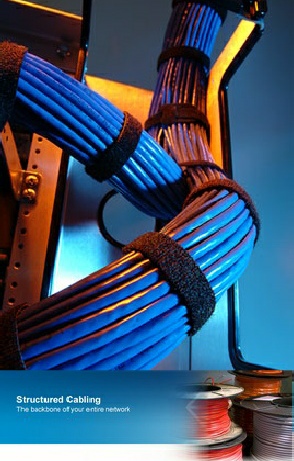
Professional Fibre Optic &
Network Cabling Services
Copyright 2015 : Portsmouth Communications Ltd, Barwell Lane, Gosport, PO13 0EQ : Reg 3886201
Portsmouth Communications
0800 652 1666
Network Cables - Technical Info
Fibre Optics
An optical fibre (or optical fibre) is a flexible, transparent fibre made of extruded glass (silica) or plastic, slightly thicker than a human hair. It can function as a waveguide, or “light pipe” to transmit light between the two ends of the fibre cable.
Optical fibres are widely used in data communications, where they permit transmission over longer distances and at higher bandwidths (data rates) than wire cables. Fibres are used instead of metal wires because signals travel along them with less loss and are also immune to electromagnetic interference.
There are many types and standards of fibre optic cable. Most commonly for smaller networks the “Multimode“ fibre type is used comprising of OM1, OM2, OM3 and OM4 standards. Each type has different capabilities for transmission distances and bandwidth. For more information download the BICSI guide.
Cat5e & Cat6
Cat5e was, until recently, the most commonly used in new installations. It’s designed to greatly reduce crosstalk which basically means that Cat5e is better at keeping signals on different circuits from interfering with each other. Cat5e supports 1000 Mbps speeds (gigabit Ethernet) at 100 MHz.
Category 6 is a major improvement over Cat5e. It's the most modern standard of network cabling. Cat6 is supports up to 10 gigabit Ethernet at 250 MHz. To even better tackle the issue of crosstalk, Cat 6 cable has an internal separator that isolates pairs from one another.
For more information download the BICSI guide
